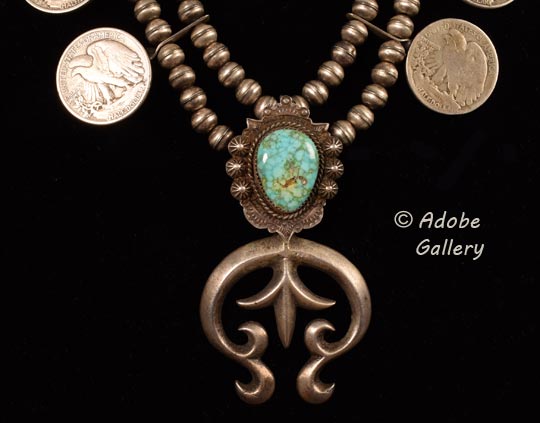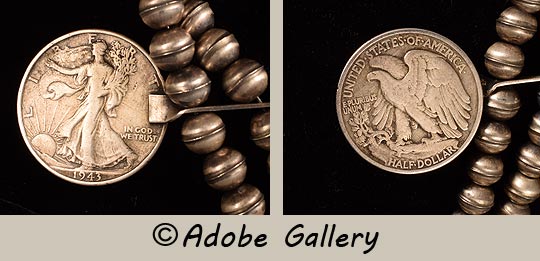Navajo Squash Blossom Necklace with Vintage Walking Liberty Half Dollar Coins [SOLD]
+ Add to my watchlist Forward to Friend
- Category: Necklaces
- Origin: Diné of the Navajo Nation
- Medium: silver, turquoise, vintage coins
- Size:
15-¼” from clasp to the end of the naja
25” from end-to-end
2-⅛” Height 3-¼” Width (cabochon and naja) - Item # C4890D SOLD
This remarkable squash blossom necklace, by Diné/Sioux jeweler Jim Urban "Chief Red Feather" Brady, likely dates to the 1960s or 1970s. It showcases Brady's exceptional craftsmanship and unique design sensibilities. The necklace features ten Walking Liberty half dollars (minted between 1937 and 1945), each with the eagle design facing outward. These coins are meticulously attached to hand-soldered sterling silver beads, which are strung on sturdy wire to form a double strand of small silver beads.
 At the centerpiece of this heirloom-quality piece is a stunning sandcast naja, a traditional crescent-shaped pendant symbolic in Navajo culture, believed to offer protection. Uniquely, this naja incorporates a turquoise cabochon set above the crescent—an unusual design element in Brady's era. The naja is marked on the back with Brady's signature hand-stamped initials, J R F, further attesting to its authenticity and his artistry.
At the centerpiece of this heirloom-quality piece is a stunning sandcast naja, a traditional crescent-shaped pendant symbolic in Navajo culture, believed to offer protection. Uniquely, this naja incorporates a turquoise cabochon set above the crescent—an unusual design element in Brady's era. The naja is marked on the back with Brady's signature hand-stamped initials, J R F, further attesting to its authenticity and his artistry.
Jim Urban "Chief Red Feather" Brady (1902-1987) was a multifaceted figure, celebrated as both a jeweler and an entertainer. For 35 years, he greeted visitors to Southern California's Knott's Berry Farm as Chief Red Feather, delighting countless park-goers with his storytelling and traditional attire. His vibrant career also included roles in over 18 Hollywood Westerns, as well as work as a deputy marshal, boxer, and rodeo horseman. This necklace serves as a testament to Brady's diverse talents and enduring legacy, blending traditional Navajo jewelry techniques with his personal flair and cultural pride.
What is a Naja? Early Navajo-made jewelry contained elements that were borrowed directly from Spanish colonial and Mexican ornament. One of these items is the naja, a crescent form of Moorish origin. The Spanish conquerors in the Southwest outfitted their horses in elaborate silver ornaments-one of which was the naja that hung directly on the forehead of the horse as a part of the bridle. Today, it is still seen in both Pueblo and Navajo modern jewelry.
Condition: good condition, with some wear on the coins consistent with its age and use. The turquoise shows a small hairline crack but remains securely set in the bezel, visible only under magnification.
Provenance: this Navajo Squash Blossom Necklace with Vintage Walking Liberty Half Dollar Coins is from a Santa Fe collector
Recommended Reading: The Navajo and Pueblo Silversmiths by John Adair
TAGS: Southwest Indian Jewelry, Sioux, Diné of the Navajo Nation, James Urban Brady



- Category: Necklaces
- Origin: Diné of the Navajo Nation
- Medium: silver, turquoise, vintage coins
- Size:
15-¼” from clasp to the end of the naja
25” from end-to-end
2-⅛” Height 3-¼” Width (cabochon and naja) - Item # C4890D SOLD



